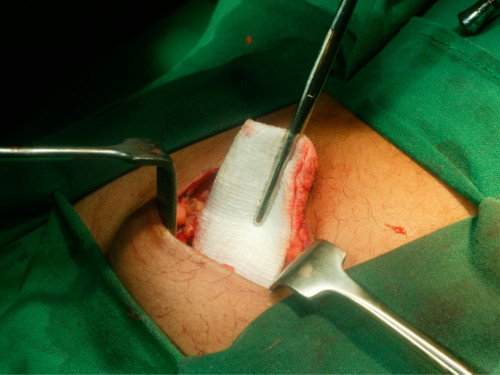A fifteen-year-long medical error
A case study highlights the ordeal of a patient that lived with a surgical sponge lodged in her abdomen for over 15 years as a result of a medical error
Published online 25 December 2014

Sponges are counted before and after a surgery to make sure that none are left behind inside the body, but human errors can occur
© Universal Images Group Limited / Alamy
Doctors in Pakistan report the case of a surgical sponge left inside a patient’s body during a medical procedure and only discovered 15 years later1.
The report, published in the Qatar Medical Journal, describes the case of a 40-year-old woman who visited the Aga Khan University Hospital in Karachi complaining of nausea, loss of appetite, and discomfort in the lower abdominal region.
The woman had been experiencing these symptoms for over 10 years. During the past five years, her appetite was reduced, she lost 3 kg in weight and experienced fewer bowel movements.
Examining her medical history, the doctors noted that she had given birth three times — twice by natural vaginal delivery, and once by emergency Caesarian section, some 15 years earlier.
Her blood tests and urinalysis were normal, so the doctors performed a CT scan of the woman’s abdomen and pelvis that yielded surprising results. The scan showed that the woman bore a rounded mass with thin metallic coils in her lower left abdomen.
The doctors then suspected that a surgical sponge had been left inside her body during the C-section surgery. After discussions with the patient and her family, the doctors decided that surgical intervention was necessary to remove the foreign body left behind. A follow-up exam performed one year later showed that the patient had recovered well and remained free of any symptoms.
“She initially developed feelings of anger and resentment towards her obstetrician,” says Muhammad Abdul Rehman, lead author of the case study. “She wanted to know if this was a direct mistake of the attending doctor and how it could even take place, [but] as her anger subsided, she realized that this was an unfortunate and rare event, and nothing had been done deliberately.”
The first case of the retention of a surgical sponge or other foreign body, called gossypiboma, was described in 1884. It is estimated to occur once in every 1,000 or 1,500 abdominal surgeries. This may be a conservative estimate, however, and it may occur more frequently.
It almost always occurs as a result of human error, and is, therefore, preventable. Some researchers are now studying whether the use of barcoded or radiofrequency identification-tagged sponges could reduce its occurrence or prevent it altogether.
“The most important measure to avoid such mishaps is to improve communication amongst members of the operating team, especially scrub nurses, technicians and surgeons,” says Abdul Rehman. “Strict adherence to sponge-counting protocols is also important.”
Reference
Rehman, A., Baloch, N. U. & Awais, M. Gossypiboma diagnosed fifteen years after a cesarean section: a case report. Qatar Med. J. 2014, 12 (2014). | article
DOI: 10.1038/qsh.2015.43

